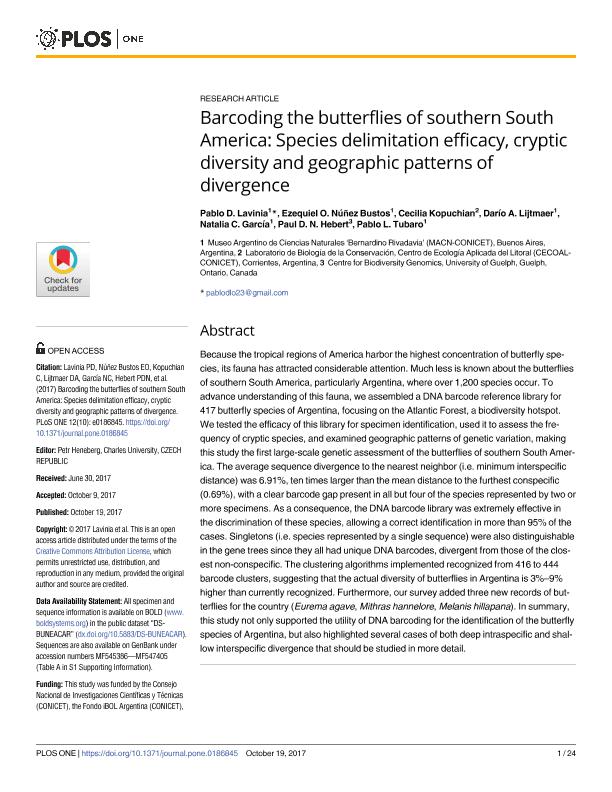Mostrar el registro sencillo del ítem
dc.contributor.author
Lavinia Oblanca, Pablo Damián

dc.contributor.author
Núñez Bustos, Ezequiel Osvaldo

dc.contributor.author
Kopuchian, Cecilia

dc.contributor.author
Lijtmaer, Dario Alejandro

dc.contributor.author
García, Natalia Cristina

dc.contributor.author
Hebert, Paul David Neil

dc.contributor.author
Tubaro, Pablo Luis

dc.date.available
2018-03-27T20:06:55Z
dc.date.issued
2017-10
dc.identifier.citation
Lavinia Oblanca, Pablo Damián; Núñez Bustos, Ezequiel Osvaldo; Kopuchian, Cecilia; Lijtmaer, Dario Alejandro; García, Natalia Cristina; et al.; Barcoding the butterflies of southern South America: Species delimitation efficacy, cryptic diversity and geographic patterns of divergence; Public Library of Science; Plos One; 12; 10; 10-2017
dc.identifier.issn
1932-6203
dc.identifier.uri
http://hdl.handle.net/11336/40220
dc.description.abstract
Because the tropical regions of America harbor the highest concentration of butterfly species, its fauna has attracted considerable attention. Much less is known about the butterflies of southern South America, particularly Argentina, where over 1,200 species occur. To advance understanding of this fauna, we assembled a DNA barcode reference library for 417 butterfly species of Argentina, focusing on the Atlantic Forest, a biodiversity hotspot. We tested the efficacy of this library for specimen identification, used it to assess the frequency of cryptic species, and examined geographic patterns of genetic variation, making this study the first large-scale genetic assessment of the butterflies of southern South America. The average sequence divergence to the nearest neighbor (i.e. minimum interspecific distance) was 6.91%, ten times larger than the mean distance to the furthest conspecific (0.69%), with a clear barcode gap present in all but four of the species represented by two or more specimens. As a consequence, the DNA barcode library was extremely effective in the discrimination of these species, allowing a correct identification in more than 95% of the cases. Singletons (i.e. species represented by a single sequence) were also distinguishable in the gene trees since they all had unique DNA barcodes, divergent from those of the closest non-conspecific. The clustering algorithms implemented recognized from 416 to 444 barcode clusters, suggesting that the actual diversity of butterflies in Argentina is 3%?9% higher than currently recognized. Furthermore, our survey added three new records of butterflies for the country (Eurema agave, Mithras hannelore, Melanis hillapana). In summary, this study not only supported the utility of DNA barcoding for the identification of the butterfly species of Argentina, but also highlighted several cases of both deep intraspecific and shallow interspecific divergence that should be studied in more detail.
dc.format
application/pdf
dc.language.iso
eng
dc.publisher
Public Library of Science

dc.rights
info:eu-repo/semantics/openAccess
dc.rights.uri
https://creativecommons.org/licenses/by-nc-sa/2.5/ar/
dc.subject
Argentina
dc.subject
Butterflies
dc.subject
Cryptic Diversity
dc.subject
Dna Barcoding
dc.subject
Molecular Operational Taxonomic Units
dc.subject
Species Discrimination
dc.subject.classification
Otras Ciencias Biológicas

dc.subject.classification
Ciencias Biológicas

dc.subject.classification
CIENCIAS NATURALES Y EXACTAS

dc.title
Barcoding the butterflies of southern South America: Species delimitation efficacy, cryptic diversity and geographic patterns of divergence
dc.type
info:eu-repo/semantics/article
dc.type
info:ar-repo/semantics/artículo
dc.type
info:eu-repo/semantics/publishedVersion
dc.date.updated
2018-03-26T17:51:48Z
dc.journal.volume
12
dc.journal.number
10
dc.journal.pais
Estados Unidos

dc.journal.ciudad
San Francisco
dc.description.fil
Fil: Lavinia Oblanca, Pablo Damián. Consejo Nacional de Investigaciones Científicas y Técnicas. Oficina de Coordinación Administrativa Parque Centenario. Museo Argentino de Ciencias Naturales ; Argentina
dc.description.fil
Fil: Núñez Bustos, Ezequiel Osvaldo. Consejo Nacional de Investigaciones Científicas y Técnicas. Oficina de Coordinación Administrativa Parque Centenario. Museo Argentino de Ciencias Naturales ; Argentina
dc.description.fil
Fil: Kopuchian, Cecilia. Consejo Nacional de Investigaciones Científicas y Técnicas. Centro Científico Tecnológico Conicet - Nordeste. Centro de Ecología Aplicada del Litoral. Universidad Nacional del Nordeste. Centro de Ecología Aplicada del Litoral; Argentina
dc.description.fil
Fil: Lijtmaer, Dario Alejandro. Consejo Nacional de Investigaciones Científicas y Técnicas. Oficina de Coordinación Administrativa Parque Centenario. Museo Argentino de Ciencias Naturales ; Argentina
dc.description.fil
Fil: García, Natalia Cristina. Consejo Nacional de Investigaciones Científicas y Técnicas. Oficina de Coordinación Administrativa Parque Centenario. Museo Argentino de Ciencias Naturales ; Argentina
dc.description.fil
Fil: Hebert, Paul David Neil. University of Guelph; Canadá
dc.description.fil
Fil: Tubaro, Pablo Luis. Consejo Nacional de Investigaciones Científicas y Técnicas. Oficina de Coordinación Administrativa Parque Centenario. Museo Argentino de Ciencias Naturales ; Argentina
dc.journal.title
Plos One

dc.relation.alternativeid
info:eu-repo/semantics/altIdentifier/doi/http://journals.plos.org/plosone/search?q=Barcoding+the+butterflies+of+southern+South+America%3A+Species+delimitation+efficacy%2C+cryptic+diversity+and+geographic+patterns+of+divergence&filterJournals=PLoSONE
dc.relation.alternativeid
info:eu-repo/semantics/altIdentifier/doi/https://doi.org/10.1371/journal.pone.0186845
Archivos asociados
